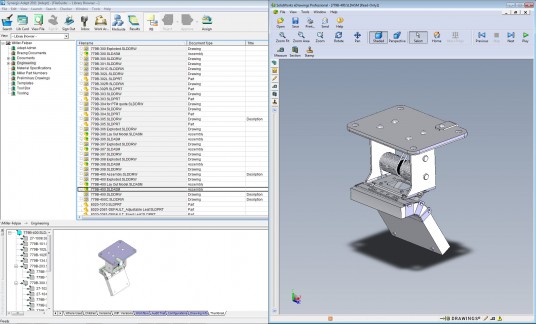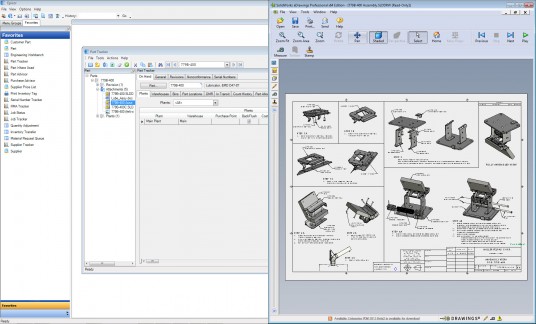Miller Felpax keeps 40-year-old locomotives on the rails with modern design technologies.
Miller Felpax Corporation is a leading manufacturer and distributor of rail parts worldwide. For over 60 years, the company has designed and manufactured locomotive, rail car, traction motor, truck, combo and gear case parts that are used in over 100 countries. Miller Felpax is the original inventor and manufacturer of traction motor lubricators and traction motor gear case seals, for both Electro-Motive Diesels (EMD) and General Electric locomotives, the leading producers of new locomotives. The company’s components can be found on virtually every locomotive in America and in most international markets. “We continue to manufacture components for the really old –30-40 year’s old—locomotives,” explains Blank, director of Engineering and Quality Assurance. “These locomotives are a very profitable part of our business.”
Michael Blank, a 34 year company veteran, is passionate about the company’s commitment to innovation, quality and securing their intellectual property. “From the very beginning of my time at Miller Felpax I was aware of an extraordinary passion for excellence,” says Blank. “We have a set of innovative products that are industry standards and which no competitor can rival. It’s genetically encoded in Miller Felpax to be creative in new product development. We’ve developed some unique, patented products. We really do a good job of protecting our Intellectual Property (IP) and keeping it secure.”

As part of the company’s mission to create and secure their innovative products, they’ve implemented 3D solid modeling and document control software. These solutions, coupled with a philosophy that “quality assurance is everyone’s responsibility” has sustained Miller Felpax’s success and profitability even through tough economic times.
An acquisition fuels better document control
The company has been using SolidWorks 3D modeling since 2001; however, their document control system evolved gradually as the company’s catalog grew to over 4000 parts.
In the late 1990s, document control was part of the company’s mandate for compliance with their own internal quality assurance system. “At that time, engineering needed a master list of parts with very basic document control methods,” recollects Blank. ”
Their first document management solution was a home-grown Microsoft Access data base that allowed them to manually track document revision levels and then distribute the paper documents. To shore up their document control efforts, they also used a work group-based Product Data Management (PDM) system. “That PDM system did an okay job for the people using SolidWorks for design and development,” recalls Blank. “But it didn’t do a great job of sharing information outside of engineering. We spent a lot of time getting drawings to other departments, such as purchasing and to customers who wanted customer-level drawings. Our engineering folks were spending more time distributing documents than performing development and design.”
In 2011, when Miller Felpax bought out a competitor, they acquired hundreds of new parts—more than they could manage with their current document controls. “We acquired around 600 top-level part numbers that we had to manage all at once. I could see that there was going to be a lot of work to enter and maintain all those part numbers in an Access database. Plus, it only really provided us a means to look at or print a master list of part numbers and revisions with no real value add.”
Finding a PDM system that served more than engineering
Aware of their existing document control limitations, Blank recommended to his boss that they find a new PDM system to eliminate all engineering paperwork and enhance communication with other departments and customers. “From there it was up to me to find or look for options for us and review them and make a suggestion
Starting in early 2011, Blank looked at a couple of PDM solutions, but “didn’t want to get so bogged down with trying to evaluate too many either.” Blank said three key factors convinced them Synergis Software’s Adept PDM system was the best choice: First, the Adept database was not encrypted like other solutions. Second, Adept had a flexible transmittal capability for tracking and managing documents that were sent outside the company. And third, Adept gave them a way to share information with their ERP system.

“We really needed a way to gain control and know what we were sending to vendors and to customers,” says Blank. “We also wanted to make it easy for others in the company to gain access to engineering information on their own so we could eliminate the widespread disruption to new product design.”
Freeing their IP from an encrypted database
One of Blank’s biggest concerns was retrieving thousands of documents, SolidWorks drawings, and parts that were locked in their existing PDM database. “We needed to un-encrypt our intellectual property,” states Blank. “We hired Synergis Software’s data migration team to do the job.”
As a result, the process of retrieving their data was straightforward and without issues. “We copied the existing workgroup database and put it on an external hard drive and overnighted it to Synergis Software,” recounts Blank. “Two days later when we were ready to implement Adept, we received that same hard drive back with all the files converted back to their native form. Our IT staff loaded those files into the database—that was it.”
Once the data was imported, the engineers took four and a half days of in-depth, on-site training and they were ready to go live with Adept.
Linking Adept to their enterprise ERP
The next stage of the implementation was integrating Adept with their ERP system. Blank’s goal was to integrate the two systems so that the design documents stored in the Adept system would be easily, reliably cross-referenced with the part number information stored in their Epicor ERP system. That way the manufacturing and engineering groups could share information without much human intervention.
“In Epicor there is a part maintenance field with an option to create an attachment. I manually created an attachment between parts in Epicor and ‘pointed’ them to a drawing in the Adept database,” explains Blank. “People on the manufacturing plant floor can then open a ‘part tracker’ in Epicor and get the details about a part’s revision; what it’s made from; and so forth. Then, it’s simple to access an attachment in the ERP system, open up work instructions, or any related inspection or control plan—all of which are managed and controlled in the Adept database. What I like best about the new process is that engineering folks don’t have to worry when changes or revisions are made to a drawing because the attachment in Epicor is always pointing to the latest file in the Adept database.”
Even better, Adept delivered accurate information to manufacturing. “The folks on the floor also don’t have to wonder if they are using the latest revision. Engineering is checking all their documentation into the Adept database, so we are 100% assured that people are using the latest version of the document.”

Early naysayers from manufacturing are now converts to the automated system. “The majority of the folks on the plant floor were a little skeptical about not having hard copy documents they could pull out of a file and view,” notes Blank. “To address that, the company invested quite a bit in placing workstations and monitors out on the plant floor. Those workstations helped get folks over the worry about not having a big piece of paper in their hands. Now the majority of people are doing everything electronically. We’re fast approaching a paperless manufacturing environment.”
Managing more than engineering drawings
Originally engineering envisioned that Adept would manage only their drawings, parts, and assemblies. In truth, they now manage, track and control a much longer list of items. “We have 359 inspection test plans or control plans, as Word documents; 126 different work constructions; and over 63 different engineering change requests,” says Blank. “So far I’d say we have 578 transmittals that we manage in Adept, plus 6,000 SolidWorks, parts, drawings, related documents, material specifications, customer drawings and customer-related specifications. That pretty much covers it.”
The company generates dozens of Engineering Change Requests (ECR), which include everything that somebody needs to complete a design: drawings, a form to record the ECR, quality manuals, safety manuals, and tool certifications. Blank has an Adept work flow set up for the engineering team, which starts out as an ECR and issues a new change request. In fact, anybody in the company can generate a new ECR. According to Blank, once someone fills out an ECR form a work flow starts in Adept and the change request goes to him. “Then I have the option to approve it or not or ask more questions,” explains Blank. “Once I approve the ECR it goes to the manufacturing manager and supervisors so that they know what’s going on. If they approve it, it goes to the Vice President of Operations. Once he gives the okay, a notification automatically goes back to engineering informing them that it’s okay to make the change.”
Sailing through ISO certification
The railway freight industry has its own version of ISO 9000/ 9001 compliance, which Miller-Felpax must achieve and maintain for competitive advantage. When an audit occurs, auditors demand that the company meet multiple requirements—most importantly document control.
“Earlier this month we went through a compliance audit and the auditor wanted to see how we controlled our documents,” recalls Blank. “Because of Adept, the audit process was much easier. There was no paper trail to worry about since Adept maintains an electronic audit trail, including detailed information of the approvals in a work flow. The audit trail also captures each and every change notifications and the emails that are sent to different people. The auditor was quite impressed with how we handled our documents.”
For internal audits, the company hires a third-party consultant and he was just as impressed with the company’s streamlined document control. “When we start talking about going paperless, most consultants say ‘oh, that’s interesting’,” observes Blank. “But then they see that people on the plant floor can get a document they need in Epicor and all those documents are controlled through Adept. So there’s really no chance that something could go wrong. They quickly realize there’s nothing more they need to audit.”
Reclaiming valuable engineering time
Looking back on the change from manual processes to Adept, Blank realizes how far they’ve come. Gone are the days when his team stopped work to distribute drawings to others in the organization.
“Our time-savings have been substantial,” concludes Blank. “I particularly like the fact that our sourcing and purchasing folks can get drawings that they need themselves. It’s a huge relief in the workload for engineering. My boss and I talk about what’s happening with engineering and our processes all the time. I know we wouldn’t have gotten near as much work done if we’d been bogged down with all of the manual document control that we were doing before Adept.”





